Description
 The roof vent is used in homes that don’t have a soffit or in a renovation whereby the homeowner wants to replace the roof vent already installed to the exhaust fan.
The roof vent is used in homes that don’t have a soffit or in a renovation whereby the homeowner wants to replace the roof vent already installed to the exhaust fan.
The Roof Vent System is ideal to use when the bathroom exhaust fan is too far away from a soffit, or the home does not have a soffit.
Our design intent was focused on the shortcomings of the standard roof vent on the market today. Common roof vents deteriorate overtime where it attaches to the roof at the silicone seal or rubber gasket.
This deterioration of most common roof vents is at the point of the attachment to the roof causing moisture damage and mold growth in the attic due to the nails that pop in the flange.
The Roof Vent is a system that is hermetically sealed. It has a damper that opens when the bath fan is on and closes when the fan is off to prevent wind, rain, snow, and pests from entering the system. The attachment of the Roof Vent is done from the interior of the attic of the roof’s sheathing eliminating the use of nails penetrating the surface of the roof. All the other roof vents are placed on the roof deck and nailed to the sheathing.
The exhaust fan transition duct is attached directly to the attic roof flange and the neck extending through the sheathing. The Roof Transition Duct snaps onto the neck of the attic flange and is locked into place.
The Roof Vent System is the only roof vent on the market that does not direct the exhausted air back onto the roofing assembly, which can deteriorate the shingles over time. The vent directs the exhausting air up and away from the roof assembly.
Our design intent was focused on the shortcomings of the standard roof vent on the market today. Common roof vents deteriorate overtime where it attaches to the roof at the silicone seal or rubber gasket.
This deterioration of most common roof vents is at the point of the attachment to the roof causing moisture damage and mold growth in the attic due to the nails that pop in the flange.


